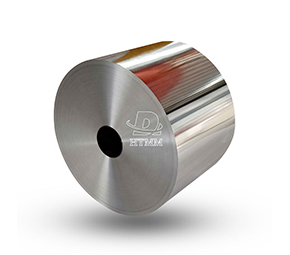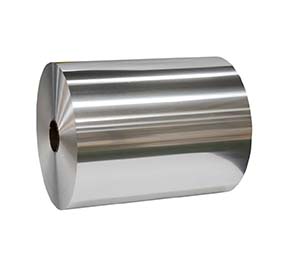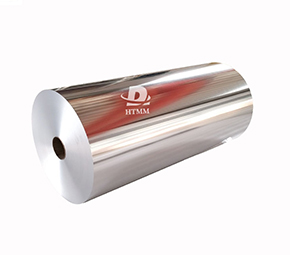Aluminum foil thickness: a complete overview
Aluminum foil is one of the most commonly used packaging materials in our daily lives. This material is not only used in cooking, packaging, but also in insulation and various industrial production. One of the most critical characteristics of aluminum foil is its thickness, as it has a significant impact on the performance, function and suitability of the foil for a specific purpose.
Aluminum foil thickness - understand the measurement units
Understanding the units used to measure the thickness of aluminum foil can effectively help to gain a deeper understanding of the specific thickness value.
The most common units for the thickness of aluminum foil are microns (μm), also known as micrometers and mils. 1 micron means one millionth of a meter, also known as 0.001 mm.
Converted to inches, 1 mil is one thousandth of an inch. 1 mil is approximately equal to 25.4 microns (μm), which can help to better understand these units.
In many parts of the world and industries, especially in areas such as science and industry where precision is required, mi crons are the preferred unit of expression.
However, in some regions, such as the United States, mils are still widely used, even in consumer products.
This dual measurement system can lead to miscommunication and miscommunication, so understanding the conversion rule (1 mil = 25.4 μm) can help eliminate misunderstandings.
Typical range of aluminum foil thicknesses
Foil thicknesses vary greatly depending on the application, so it is important to choose the best foil for the application.
Foil has a wide range of applications, from very thin foils used in professional industries to thicker foils designed for heavy-duty use.
Ultra-thin foil: (less than 6 microns thick)
Aluminum foil with a thickness of less than 6 microns is often called "ultra-thin" foil. This foil has excellent flexibility, is very light due to its ultra-thinness, and has a high surface area to volume ratio. These characteristics make ultra-thin foil a popular choice in highly specialized fields.
The electronics industry is one of the main applications of ultra-thin foil. When used in capacitors, the ultra-thin thickness allows aluminum foil to help products achieve high capacitance in a small volume, improving the functionality of the product. When used as an electrode, ultra-thin foil can help capacitors store more electrical energy. In addition, ultra-thin aluminum foil can also be used as a current collector in lithium-ion batteries to promote the flow of electrons between battery electrodes and improve the efficiency of electronic products.
Another major application area of ultra-thin aluminum foil is packaging sensitive materials. For example, pharmaceuticals, electronic components, etc. The ultra-thin thickness of aluminum foil can minimize the amount of material used, maintaining the characteristics of small and light products, while retaining the characteristics of aluminum foil, blocking moisture, oxygen and other contaminants, protecting products and extending their service life.
Thin aluminum foil: (6 μm to 25 μm)
Aluminum foil with a thickness between 6 μm and 25 μm is called thin aluminum foil. Aluminum foil in this thickness range is usually used in households and the catering service industry. Because this thickness range can maintain maximum flexibility and strength, and is the most cost-effective, it can save a lot of costs for households, manufacturers and other users.
In daily kitchen use, thin aluminum foil is often used to wrap or support food. When cooking, aluminum foil can be covered on tableware or spread on baking trays to keep food and tableware clean. The flexibility of thin aluminum foil also means that it can fit the shape of food well, meeting the wrapping needs of different shapes of food while keeping the food evenly heated during the cooking process to prevent moisture loss. When aluminum foil is used for grilling, it can keep clean while locking in moisture, keeping food fresh and tender, and preventing sticking.
Thin aluminum foil is also widely used in the food packaging industry. It is often used as a coating for packaging materials, taking advantage of the light-shielding, moisture-proof and oxygen-barrier properties of aluminum foil. This has greatly improved the shelf life of food packaging. It has a wide range of applications, such as packaging of snacks, chocolate, beverages, processed meats and other ingredients that need to extend the shelf life and keep fresh.
Medium-thick aluminum foil: (25 microns to 100 microns)
Aluminum foil with a thickness of 25 microns to 100 microns is called medium-thick aluminum foil. Aluminum foil in this thickness range has higher rigidity and puncture resistance. Therefore, it is suitable for industries that require higher strength and durability than thin aluminum foil, such as industrial and commercial uses.
Thermal insulation is one of the characteristics of thick aluminum foil. Used for building insulation: it can reflect heat and reduce energy consumption. When aluminum foil is compounded with other materials: for example, it is laminated with materials such as fiberglass or foam to make insulation boards, which can be installed in walls, roofs, floors and other building materials, effectively blocking the damage of temperature to building materials and extending the service life of building materials.
Packaging larger items is also an application of medium-thick aluminum foil. For example: electrical appliances, mechanical parts and industrial components. The strength and durability of medium-thick aluminum foil effectively protects large items during transportation and storage, preventing damage to items caused by external factors such as scratches, dents and corrosion, and reducing possible repair costs.
Thick aluminum foil: (100 microns and above)
Aluminum foil with a thickness of 100 microns and above is called thick aluminum foil. Heavy-duty applications that require high strength and stiffness require this type of thick aluminum foil. Due to the rigidity of thick aluminum foil, this type of aluminum foil is not as flexible as thin aluminum foil, but its excellent puncture and tear resistance makes it shine in the right fields.
In industrial environments, thick aluminum foil has a wide range of uses. In the construction industry, it can be used as a vapor barrier to prevent moisture from passing through walls, roofs, floors and other places that need to be kept warm and moist. In the automotive industry, its main application is its thermal insulation function, helping to protect sensitive components from the high temperatures generated by the engine and exhaust system, maintaining the normal operation of the components.
In the packaging industry, thick aluminum foil is often used to package large or heavy items, such as industrial chemicals, lubricants and bulk foods. Its strength and durability help keep the packaging intact during transportation and storage.
Factors Affecting Foil Thickness
The thickness of aluminum foil is not determined arbitrarily, but is affected by a variety of factors. Different foil thicknesses are determined according to the manufacturing process, the type of aluminum alloy used, the intended use, etc., all of which will make the appropriate foil thickness different.
Manufacturing process
The manufacturing of aluminum foil involves a series of rolling processes, including rough rolling and finishing rolling. The process starts with a thick aluminum plate, which is heated and rolled into a thin plate. After this, the thin plate passes through a series of rolling mills, each of which further reduces the thickness of the aluminum plate. The number of rolling passes and the pressure applied during each rolling process determine the final thickness of the aluminum foil.
During the rolling process, precision is crucial to ensure that the aluminum foil maintains a uniform thickness. Any changes in pressure or speed during the rolling process may cause uneven thickness of the aluminum foil, which will affect the performance of the aluminum foil. Modern rolling mills are equipped with advanced sensors and control systems. The equipment of these devices can monitor and adjust rolling parameters in real time, greatly improving rolling accuracy and ensuring consistent thickness.
Aluminum Alloys
The thickness of the foil also depends on the type of aluminum alloy used. Different alloys are selected based on the mechanical properties they require, such as strength and ductility, which affects how easily they can be rolled into thin foil.
Pure aluminum (1xxx series alloys) is very ductile and can be rolled into very thin foil. However, maintaining excellent ductility means sacrificing strength, which limits its use to high-strength applications.
Alloys containing other elements (such as copper, manganese or magnesium) (such as 3xxx, 5xxx and 8xxx series) are stronger but less ductile, so rolling them into very thin foil during production is more challenging than 1xxx series alloys.
The appropriate alloy needs to be selected based on the intended use of the foil. For example, for high-strength applications, a slightly thicker and stronger alloy can be selected. Conversely, if a thinner foil with good flexibility is required, a pure aluminum alloy or a more ductile alloy can be selected.
Intended Use
The intended use of the foil is perhaps the most important factor affecting its thickness. The thickness of aluminum foil needs to be adjusted according to specific needs, with different performance to suit the needs of different applications.
For example, in food packaging, aluminum foil needs to be thick enough to block moisture, oxygen and light, while also being flexible enough to fit the shape of the food. In contrast, in industrial applications, such as insulation materials, the thickness of aluminum foil is adjusted according to the required heat resistance and durability, which requires thick and rigid aluminum foil.
The Importance of Precise Thickness Control
Precise control of aluminum foil thickness can effectively guarantee the performance of aluminum foil and ensure that its performance and function in various applications are maximized. Even small changes in thickness can have a significant impact on the performance of aluminum foil.
Therefore, during the production process, aluminum foil manufacturers use advanced measurement and quality control technologies to ensure precise thickness control.
Online thickness gauges (such as X-ray or laser thickness gauges) can measure the thickness of aluminum foil during the rolling process to make real-time adjustments. In addition, offline testing is also an essential step, and multiple tests are performed to verify the thickness of the finished product to ensure that it meets the specified requirements.
Conclusion
Aluminum foil thickness is a key parameter that determines its suitability for various applications and also determines product quality. From ultra-thin aluminum foil used in electronic products to thick aluminum foil used in industrial environments, various thicknesses can be customized to specific performance requirements. Understanding the different thickness ranges, factors that affect thickness, and the importance of precise thickness control can help select the right aluminum foil for different application scenarios.
As technology continues to advance and market needs continue to adjust, aluminum foil thickness control will become more precise, and it will become a general trend to produce aluminum foil with better performance. This continuous innovation ensures that aluminum foil will continue to be widely used in various industries and is an inevitable choice as one of the indispensable materials in the coming years.





